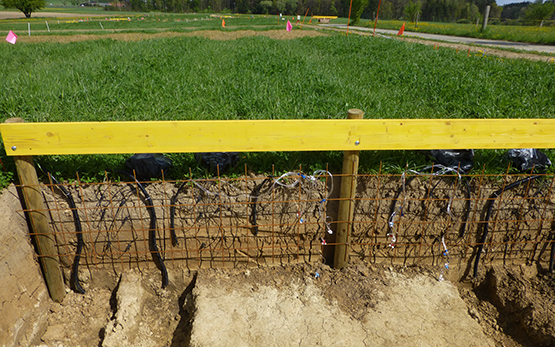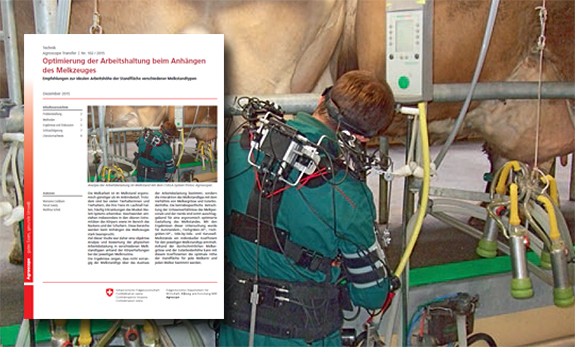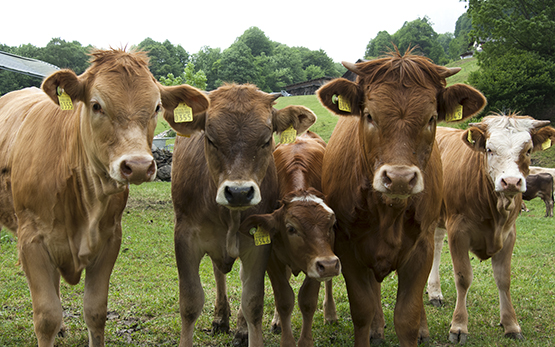Gazzarin C.
Grundfutter wirtschaftlich betrachtet: Grundfutteranteil und Milchleistungsniveau in einer Vollkostenbetrachtung.
In: Strickhof Milch-Tag. 27. Januar, Hrsg. Strickhof, Lindau. 2023, 1-22.
Gazzarin C.
Wirtschaftliche und standortangepasste Mutterkuhhaltung.
In: Fleischrindersymposium. 19. Januar, Hrsg. Plantahof, Landquart. 2023, 1-38.
Gazzarin C., Blättler T., Bütler A., Durgiai B., Schmid D.
Bergmilchproduktion mit Zweinutzungskühen – alter Zopf oder wieder rentabel?
Agrarforschung Schweiz, 13, 2022, 190-197.
Kozak O., Renner S., Jan P., Gazzarin C.
World dairy market: Challenges and opportunities: Main findings of the 23rd IFCN Dairy Conference 2022.
Agroscope Science, 140, 2022, 1-5.
Gazzarin C.
Rindfleisch aus Gras: Welche Strategien sind wirtschaftlich?
In: Agrarökonomie-Tagung. 04. Oktober, Tänikon, Ettenhausen, Agroscope. 2022.
Gazzarin C.
Wirtschaftliche und standortangepasste Mutterkuhhaltung.
In: Beef.ch. 24. Juni, Strickhof Wülflingen. 2022.
Gazzarin C.
Erste Ergebnisse zur Wirtschaftlichkeit von Mutterkuhhaltungssystemen.
In: Zentralschweizer Regionaltagung Mutterkuh Schweiz. 7. Mai, Hrsg. Mutterkuh Schweiz, Arenenberg und Strickhof, Willerswil. 2022.
Gazzarin C., Bütler A., Anken T., Bravin E., Hoop D., Sax M., Schlatter M., Zorn A.
Kostenkatalog 2022: Richtwerte für die Kosten von Maschinen, Arbeit, Gebäude und Hoftechnik. Gültig bis September 2023.
Agroscope Transfer, 448, 2022, 1-56.
weitere Sprachen: französisch
Gazzarin C., Jan P.
Wirtschaftlich optimale Produktionssysteme in der Mutterkuhhaltung: Eine ökonomische Analyse basierend auf 42 Mutterkuhbetrieben im Tal- und Berggebiet.
Agroscope Science, 138, 2022, 1-34.
Gazzarin C.
Optimierte Produktionssysteme in der Mutterschafhaltung – Produktivität als Schlüssel zum Erfolg.
In: Wirtschaftlichkeit von Mutterschafen - Optimierte Produktionssysteme. 10. Mai, Agridea. 2022, 1-38.
Gazzarin C.
Systèmes de production rentables en production ovine.
In: Systèmes de production rentables en production ovine. 26.11., Villarepos - Proconseil Lausanne (Prometerre). 2021.
Schlebusch S., Gazzarin C., Hoop D., von Rohr P.
Ecobreed: The economic value of a cow as a selection criterion.
In: EAAP. 02.09., Davos. 2021.
Gazzarin C.
Wie viel soll verrechnet werden?
Schweizer Landtechnik, 12, 2021, 30-32.
weitere Sprachen: französisch
Gazzarin C.
Verrechnungsansätze für Schneeräumarbeiten: Gültig bis September 2022.
Hrsg. Agroscope, 03. September, 2021, 1 S.
weitere Sprachen: französisch
Gazzarin C., Häller B., Hofstetter P.
Economic potential of milk production strategies with restrictive use of concentrated feed: An experiment on 36 family farms in the pre-alpine region.
Grassland Science, 67, (4), 2021, 343-351.
Gazzarin C., Hoop D.
Was kostet das Tierwohl?
In: Agrarökonomie-Tagung. 5. Oktober, Hrsg. Agroscope, Tänikon. 2021, 1-27.
Gazzarin C.
Maschinenkosten 2021: gültig bis September 2022.
Agroscope Transfer, 408, 2021, 1-52.
weitere Sprachen: französisch
Scriba M.F., Keil N., Zanolari P., Gazzarin C.
Beurteilung des Tierwohls und der Wirtschaftlichkeit in der Lämmer- und Gitzimast.
forum, 6/7, 2021, 6-8.
weitere Sprachen: französisch
Gazzarin C., Meier L., Zimmert F.
Wirtschaftlichkeit von Rindvieh- und Schweinemastbetrieben mit höherem Tierwohlstandard: Sind die Mehrkosten gedeckt?
Agroscope Transfer, 399, 2021, 1-12.
weitere Sprachen: französisch
Gazzarin C., Zimmert F.
Was ist uns das Tierwohl wert?: Berechnungen aus der Schweiz.
Berichte über Landwirtschaft, 99, (1), 2021, 1-27.








